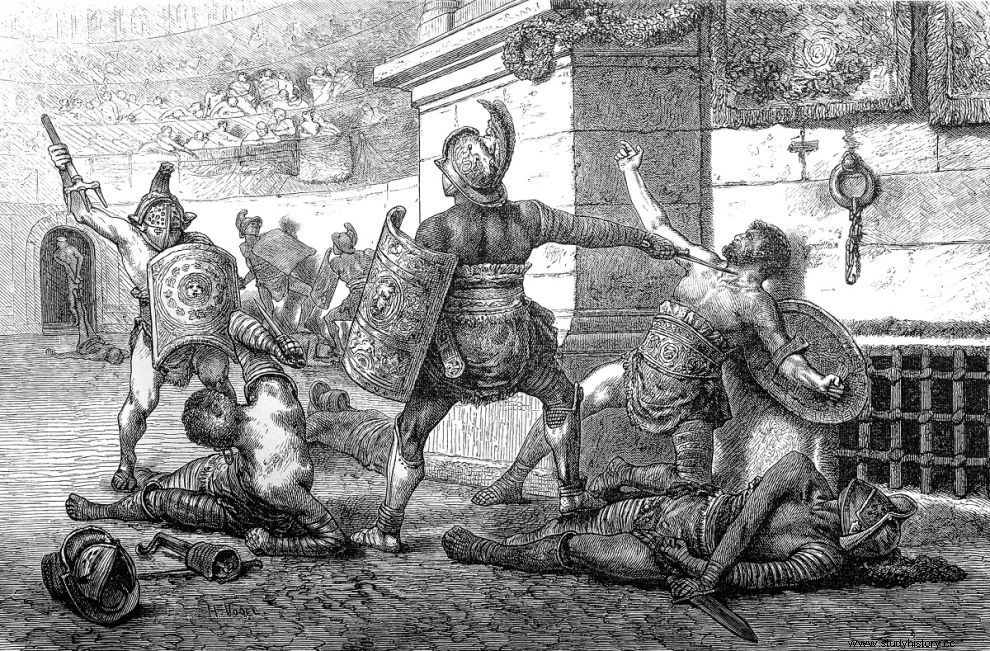And yet, one can easily find references in recorded history to women who fought in the arena. They may not be the most well-known cases, they may not immediately come to mind when we hear the word "Coliseum", but in the pursuit of originality and "television", the entrepreneurs of the genre - yes, there were those - were constantly looking for ways to to keep the interest alive. And one of these ways was the duels between women.
Historians of those times described the "spectacle" as something that took place in the 1st century BC after dinner, with women dueling either with other women or with wild beasts, even dwarfs.
The emperors Nero, Titus and Domitian were just some of the emperors who had hosted such spectacles in their court, with some of them also taking place in the then flourishing city of Pompeii. But in general it happened in several cities. For example there is an inscription found in the port of Ostia showing a local magistrate boasting that he was the first since the day his city was founded to "provide women for the sword".

Rich female gladiators
Women of all social classes participated in the spectacle. "Slaves who worked for wealthy families may have attracted the interest of a local businessman, who may have seen them as an opportunity," said David Potter, a professor of classics at the University of Michigan who has written extensively about the ancient sports.
"He would tell you:'You are strong. Let's train you as a gladiator. You will make a lot of money from your fights.'"
Women of the middle and upper classes also entered the ring, for the same reasons as the rich young men of the time. "It's exciting, it's different, and it pissed off their parents," Potter continues.
At that time, women were involved in various sports anyway and those who kept in good shape, heard many complimentary comments from those around them and especially from the Roman officials who wanted to see them fit, as they thought that way they would have a better childbirth.
Affluent women could afford the financial cost of training and had the free time to exercise. Thus, professional managers of gladiator troupes encouraged those who excelled in wrestling to try their luck in duels, which offered more money and more glamour.
"If you look at it all as a form of entertainment, it becomes clearer why women wanted to do it," says Potter.
The Roman Senate passed laws in 11 and 19 AD. which prohibited middle- and upper-class women from fighting as gladiators—apparently to little effect, however, since reports of women gladiators continued for two more centuries.

Portrayals of female gladiators in art
Only one surviving work of art, housed in the British Museum, clearly depicts female gladiators:an ancient marble relief found in Halicarnassus, which shows two women fighting with shields, swords and leg guards. The figures bear the names "Amazon" and "Achillea", probably artistically, which refer directly to Greek mythology. An inscription above their heads indicates that the result of the "fight" was an honorable draw for both.
At the same time, there may be some other artworks showing female gladiators that we may have misinterpreted, scholars say. For example, a bronze sculpture from the 1st century AD, kept in the Museum of Arts and Crafts in Germany, was for years thought to show a woman holding a cleaning implement. But a 2011 re-evaluation by a Spanish scholar suggests that it is more likely to show a female gladiator triumphantly raising a short, curved sword, called a "sica". The fact that she is topless, as gladiators usually fought, also contributes to this interpretation.
One of the most interesting discoveries was made in 1996, when archaeologists from the Museum of London discovered a fragment of a female pelvis among the cremated ashes of an elaborate Roman-era tomb in Southwark, London. Decorative objects and the remains of a lavish funeral suggest that it was the burial place of a gladiator.
Jenny Hall, curator of the Museum of London at the time, said it was 70% likely to be a female gladiator, although some skeptics said the "Great Dover Street Woman" as it was called, could have been a gladiator's wife or a his fan.

The tradition of the gladiators
There is much more surviving evidence of male gladiators, who fought for almost a thousand years throughout the Roman Empire. In the city of Rome itself, gladiatorial contests began as part of lavish funeral ceremonies in the first centuries BC, particularly among the more politically ambitious aristocrats. For example in 65 BC, Julius Caesar used 320 pairs of gladiators to - ostensibly - honor his long-dead father. Although the fights were bloody, gladiators were seen as models of strength and valor who could inspire the crowds to greater faith in Rome.
Many male gladiators were slaves or prisoners of war, but there were also young free citizens who chose to risk their lives in pursuit of fame and money. After all, the popular gladiators were considered sex symbols and used to experience apotheosis in the corresponding bars of Rome today.
Thus, training schools at one time proliferated, with event sponsors going so far as to hire entire gladiator troupes. Fighters often shared the pay, while slaves fought in the hope that they could buy their freedom after a few victories.
Unlike what we've seen in Hollywood, gladiators rarely fought to the death. A defeated gladiator would raise one finger, leaving the sponsor to decide his fate, often with input from the audience. But killing a gladiator required the sponsor to pay the troupe manager a hefty fee, almost ten times the rental cost. It didn't help him because of that, and the odds of a gladiator dying in any given match were about 5%, according to Potter.
The innovation of female gladiators
Audiences craved novelty, which prompted sponsors to offer ever more exotic performances, and female gladiators fighting each other fit the bill. According to the Roman historian, Cassius Dio, Nero organized a demonstration match in 59 AD. "which became more shameful and shocking at the same time, when men and women not only of the middle class but even of the senatorial class rode horses, killed wild beasts, and fought as gladiators, some willingly and some against his will."
In 66 AD, Nero once again had women duel in honor of his mother's memory - whom, of course, he himself had murdered.
The emperor Domitian held gladiatorial contests at night by torchlight, sometimes pitting the women against dwarfs as well as each other, according to Cassius Dio and Suetonius, another great Roman historian.
What did Roman society believe
However, Roman society still did not have the best view of married women competing in the arena. It is characteristic that the Roman poet, Juvenal, once mocked men who allowed their wives to fight, writing:
“What a great honor it is for a husband to see, at an auction, where his wife's accessories are being sold:belts, shin guards, arm guards and headgear! Hear her moan as she struggles and thrusts. See her neck bend under the weight of her helmet".
In 200 AD, the emperor Septimius Severus finally banned all combat between female gladiators after he once heard such obscene jokes against women participating in a fight that he feared the "sport" would instill disrespect for all women. women.
Public interest in gladiators had waned greatly by the fifth century - partly due to the spread of Christianity, which found the spectacle abhorrent, and partly due to the cost of staging such events, which was prohibitive after the collapse of the Western Roman Empire. Empire. And somewhere there the gladiators ceased to exist forever.
